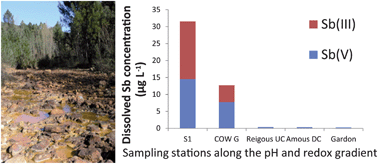Fate of Sb(v) and Sb(iii) species along a gradient of pH and oxygen concentration in the Carnoulès mine waters (Southern France)
Abstract
The speciation and behaviour of antimony were investigated in surface waters downstream from the abandoned Pb–Zn Carnoulès mine (Gard, France). These waters exhibit a permanent gradient of oxygen concentration and pH, ranging from acid suboxic in Reigous Creek at the outlet of sulfide tailings impoundment, to near neutral oxygenated at downstream sites along the rivers Amous and Gardon. The concentration of total dissolved (<0.22 μm) antimony, acquired through a seven-year monitoring, decreased from 7.7–409.9 μg L−1 at the source of Reigous Creek to 0.22–0.45 μg L−1 in the Gardon River, showing natural Sb attenuation. Speciation analysis carried out during three surveys indicated that Sb(III) represented up to 70% of the total dissolved Sb concentration at the source of Reigous Creek, while Sb(V) represented less than 50%. Field characterization showed that Sb(III) and Sb(V) species were attenuated through dilution and were also removed from the dissolved phase during downstream transport. Speciation analysis in suspended particulate matter extracts gave a distribution of particulate Sb into 70 to 100% of Sb(III) and less than 30% of Sb(V). The removal of Sb(III) and Sb(V) species from the dissolved phase was concordant with the oversaturation of Reigous Creek


 Please wait while we load your content...
Please wait while we load your content...